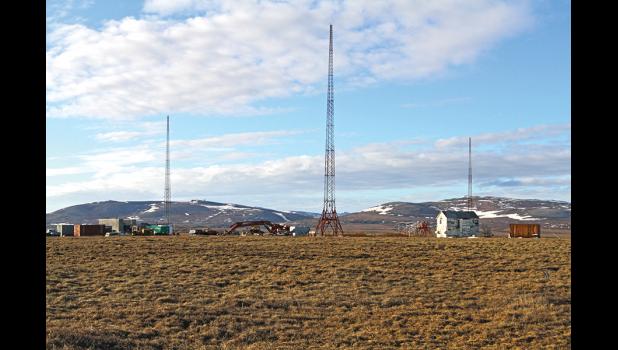FAA to remove Beam Road towers, other contamination
Three officials with the Federal Aviation Administration were in Nome this week to begin the process of assessing soil contamination at the old communication and navigation facility near mile 1 of the Beam Road.
Currently, three white and red towers, some leaning more than others, in addition to several downed towers litter the property that once was used to beam sound waves that guided pilots to the Nome airport. As technology improved, the system became obsolete and was replaced with the VOR site near the Nome River and eventually more modern GPS systems.
Now, the site has moved up on the FAA’s list of places to clean up and the process began last year when the FAA’s Contaminated Sites program director Brad Platt and project engineer Jon Schleder traveled to Nome to sort out ownership of the land and to do a site survey.
Usually, the CAA – as the FAA was called back in the 1940s – used federal lands to build supporting infrastructure for airports on. However, things were different in Nome. According to a time line provided by Platt, the Nome airport was developed in 1941. The following year, the CAA entered into a lease agreement with the Harrison-Munn Corporation to built and maintain the air navigation and communication facilities, about three miles east of the Nome airport. There were four 140-ft steel transmission towers erected near the Beam Road plus a building and a Quonset hut with several oil tanks and, three 250-ft. high towers, a generator building and more oil tanks on the far end of the 46-acre property, towards Gold Hill. The communication facility was active until 1949, the navigation station until 1967.
In 1975 the lease agreement ended and the land was returned to the Harrison-Munn Corporation. The three tall communications towers were dropped onto the tundra and everything except for the Quonset hut remained on the property. In 1987, Gary Longley bought the property in order to develop a Nome landfill, but the land proved unsuitable for the purpose due to the amount of permafrost present. The land was divided and another person, Chilly Belarde, bought the communications facility, and at a later time, a one acre parcel was acquired by Paul Haskell.
Last year, the FAA received the green light from the property owners to access the land and begin the remediation process.
During a very sparsely attended meeting at Old St. Joe’s on Monday evening, FAA Regional Administrator Kerry Long, Platt and Schleder informed the three people in attendance, namely Nome Mayor Richard Beneville, property owner Paul Haskell and Planning Commissioner Ken Hughes, about their intentions and purpose.
Possible contamination at the site could include oil leaking from the present fuel tanks, chlorinated solvents, lead contamination and PCBs associated with transformers.
Platt said the plan is to conduct a massive soil sampling effort this summer, to determine how much contamination there is and how involved the removal of contamination would be. The next step would be to demolish the infrastructure on the property. Platt said, “We don’t know how wide, how deep and how bad it is.” He said he doesn't expect the worst, but people driving by should not be alarmed when they see workers dressed in white Tyvek suits, donning respirators as they sample the soil.
Platt said that the project is fully funded, but couldn’t put a price tag on the effort, since the sampling has not been done yet to determine the amount of cleanup to be conducted. However, he said that the downed towers resting in tundra ponds will bring the price of the endeavor up because it will be hard to get the towers first out of the water and then across the waterlogged tundra to be hauled off to special hazmat dump sites in the lower 48.
Beneville and Hughes both emphasized that they were glad to see the FAA address the contamination issue and step up to clean up the site. “We’re glad to seem them cleaned up,” said Hughes. “There is a lot of contamination left here and in the villages. There are now health issues consistent with contamination. This is not far from the center of our attention.”

